Geospatial Analysis of Relief Degree of Land Surface in the Forest-Steppe Ecotone in Northern China
Abstract
1. Introduction
2. Materials and Methods
2.1. Study Area
2.2. Data Sources
2.3. Research Method
2.3.1. Window Analysis Method
2.3.2. Mean of Change-Point Method
2.3.3. RDLS Model
2.3.4. Spatial Autocorrelation Analysis
Global Moran’s I
Local Moran’s I
3. Results
3.1. Distribution of RDLS under Optimal Window
3.1.1. Determination of Optimal Analysis Window for RDLS Based on the Mean of the Change-Point Method
3.1.2. RDLS under the Optimal Analysis Window
3.2. Distribution Characteristics of the RDLS by Latitude and Longitude under Optimal Analytical Window
3.2.1. Distribution Characteristics of the RDLS in the Latitude Direction under the Optimal Analysis Window
3.2.2. Distribution Characteristics of RDLS in the Longitudinal Direction under Optimal Analysis Window
3.3. Spatial Auto-Correlation Analysis and Significance Test
3.4. Correlation Analysis among RDLS and Both Mean Elevation and Relative Elevation Difference
4. Discussion
5. Conclusions
Author Contributions
Funding
Data Availability Statement
Acknowledgments
Conflicts of Interest
References
- Wang, B.; Cheng, W. Effects of Land Use/Cover on Regional Habitat Quality under Different Geomorphic Types Based on InVEST Model. Remote Sens. 2022, 14, 1279. [Google Scholar] [CrossRef]
- Liu, Y.; Chen, J.; Sun, X.; Li, Y.; Zhang, Y.; Xu, W.; Yan, J.; Ji, Y.; Wang, Q. A Progressive Framework Combining Unsupervised and Optimized Supervised Learning for Debris Flow Susceptibility Assessment. CATENA 2024, 234, 107560. [Google Scholar] [CrossRef]
- Wang, Z.; Hu, Z.; Liu, H.; Gong, H.; Zhao, W.; Yu, M.; Zhang, M. Application of the Relief Degree of Land Surface in Landslide Disasters Susceptibility Assessment in China. In Proceedings of the 2010 18th International Conference on Geoinformatics, Beijing, China, 18–20 June 2010; pp. 1–5. [Google Scholar]
- Wu, J.; Zhang, Y.; Yang, L.; Zhang, Y.; Lei, J.; Zhi, M.; Ma, G. Identifying the Essential Influencing Factors of Landslide Susceptibility Models Based on Hybrid-Optimized Machine Learning with Different Grid Resolutions: A Case of Sino-Pakistani Karakorum Highway. Environ. Sci. Pollut. Res. 2023, 30, 100675–100700. [Google Scholar] [CrossRef]
- Yang, Z.; Pang, B.; Dong, W.; Li, D.; Huang, Z. Interaction of Landslide Spatial Patterns and River Canyon Landforms: Insights into the Three Parallel Rivers Area, Southeastern Tibetan Plateau. Sci. Total Environ. 2024, 914, 169935. [Google Scholar] [CrossRef]
- Yang, N.; Jiang, L.; Chao, Y.; Li, Y.; Liu, P. Influence of Relief Degree of Land Surface on Street Network Complexity in China. ISPRS Int. J. Geo-Inf. 2021, 10, 705. [Google Scholar] [CrossRef]
- Sui, G.; Hao, B.; Feng, G.; Sun, B. Data Analysis of Elevation Standard Deviation Classifying Geomorphological Types. In Proceedings of the 2010 International Conference on Computer Application and System Modeling (ICCASM 2010), Taiyuan, China, 22–24 October 2010; pp. V15-294–V15-297. [Google Scholar] [CrossRef]
- Chen, S.; Wang, X.; Lin, Q. Spatial Pattern Characteristics and Influencing Factors of Mountainous Rural Settlements in Metropolitan Fringe Area: A Case Study of Pingnan County, Fujian Province. Heliyon 2024, 10, e26606. [Google Scholar] [CrossRef]
- Li, Y.; Du, J.; Ran, D.; Yi, C. Spatio-Temporal Distribution and Evolution of the Tujia Traditional Settlements in China. PLoS ONE 2024, 19, e0299073. [Google Scholar] [CrossRef]
- Liu, Y.; Deng, W.; Song, X. Relief Degree of Land Surface and Population Distribution of Mountainous Areas in China. J. Mt. Sci. 2015, 12, 518–532. [Google Scholar] [CrossRef]
- Wu, W.; Niu, S. Evolutional Analysis of Coupling between Population and Resource-Environment in China. Procedia Environ. Sci. 2012, 12, 793–801. [Google Scholar] [CrossRef]
- Yang, Y.; Feng, Z.; Wang, L.; You, Z. Research on the Suitability of Population Distribution at the Provincial Scale in China. J. Geogr. Sci. 2014, 24, 889–906. [Google Scholar] [CrossRef]
- Huang, D.; Su, L.; Fan, H.; Zhou, L.; Tian, Y. Identification of Topographic Factors for Gully Erosion Susceptibility and Their Spatial Modelling Using Machine Learning in the Black Soil Region of Northeast China. Ecol. Indic. 2022, 143, 109376. [Google Scholar] [CrossRef]
- Deng, J.; Cheng, W.; Liu, Q.; Jiao, Y.; Liu, J. Morphological Differentiation Characteristics and Classification Criteria of Lunar Surface Relief Amplitude. J. Geogr. Sci. 2022, 32, 2365–2378. [Google Scholar] [CrossRef]
- Jiang, W.; Pan, H.; Yang, N.; Xiao, H. Dam Inundation Duration as a Dominant Constraint on Riparian Vegetation Recovery. Sci. Total Environ. 2023, 904, 166427. [Google Scholar] [CrossRef]
- Jin, H.; Zhong, R.; Liu, M.; Ye, C.; Chen, X. Spatial Risk Occurrence of Extreme Precipitation in China under Historical and Future Scenarios. Nat. Hazards 2023, 119, 2033–2062. [Google Scholar] [CrossRef]
- Pan, W.; Wang, J.; Li, Y.; Chen, S.; Lu, Z. Spatial Pattern of Urban-Rural Integration in China and the Impact of Geography. Geogr. Sustain. 2023, 4, 404–413. [Google Scholar] [CrossRef]
- Chen, Y.; Li, Y.; Wang, L.; Duan, Y.; Cao, W.; Wang, X.; Li, Y. Heterogeneity of Leaf Stoichiometry of Different Life Forms along Environmental Transects in Typical Ecologically Fragile Areas of China. Sci. Total Environ. 2024, 910, 168495. [Google Scholar] [CrossRef]
- Du, X.-F.; Liu, H.-W.; Li, Y.-B.; Li, B.; Han, X.; Li, Y.-H.; Mahamood, M.; Li, Q. Soil Community Richness and Composition Jointly Influence the Multifunctionality of Soil along the Forest-Steppe Ecotone. Ecol. Indic. 2022, 139, 108900. [Google Scholar] [CrossRef]
- Wang, L.; Jia, Z.; Li, Q.; He, L.; Tian, J.; Ding, W.; Liu, T.; Gao, Y.; Zhang, J.; Han, D.; et al. Grazing Impacts on Soil Enzyme Activities Vary with Vegetation Types in the Forest-Steppe Ecotone of Northeastern China. Forests 2023, 14, 2292. [Google Scholar] [CrossRef]
- Li, B.; Li, Y.; Fanin, N.; Han, X.; Du, X.; Liu, H.; Li, Y.; Li, Q. Adaptation of Soil Micro-Food Web to Elemental Limitation: Evidence from the Forest-Steppe Ecotone. Soil Biol. Biochem. 2022, 170, 108698. [Google Scholar] [CrossRef]
- Schmidt, M.; Jochheim, H.; Kersebaum, K.-C.; Lischeid, G.; Nendel, C. Gradients of Microclimate, Carbon and Nitrogen in Transition Zones of Fragmented Landscapes—A Review. Agric. For. Meteorol. 2017, 232, 659–671. [Google Scholar] [CrossRef]
- Erdős, L.; Ambarlı, D.; Anenkhonov, O.A.; Bátori, Z.; Cserhalmi, D.; Kiss, M.; Kröel-Dulay, G.; Liu, H.; Magnes, M.; Molnár, Z.; et al. The Edge of Two Worlds: A New Review and Synthesis on Eurasian Forest-Steppes. Appl. Veg. Sci. 2018, 21, 345–362. [Google Scholar] [CrossRef]
- He, P.; Fontana, S.; Ma, C.; Liu, H.; Xu, L.; Wang, R.; Jiang, Y.; Li, M.-H. Using Leaf Traits to Explain Species Co-Existence and Its Consequences for Primary Productivity across a Forest-Steppe Ecotone. Sci. Total Environ. 2023, 859, 160139. [Google Scholar] [CrossRef]
- Liu, F.; Liu, H.; Xu, C.; Zhu, X.; He, W.; Qi, Y. Remotely Sensed Birch Forest Resilience against Climate Change in the Northern China Forest-Steppe Ecotone. Ecol. Indic. 2021, 125, 107526. [Google Scholar] [CrossRef]
- Hou, G.; Delang, C.O.; Lu, X. Afforestation Changes Soil Organic Carbon Stocks on Sloping Land: The Role of Previous Land Cover and Tree Type. Ecol. Eng. 2020, 152, 105860. [Google Scholar] [CrossRef]
- Zhang, Z.; Hao, M.; Li, Y.; Shao, Z.; Yu, Q.; He, Y.; Gao, P.; Xu, J.; Dun, X. Effects of Vegetation and Terrain Changes on Spatial Heterogeneity of Soil C–N–P in the Coastal Zone Protected Forests at Northern China. J. Environ. Manag. 2022, 317, 115472. [Google Scholar] [CrossRef]
- Zethof, J.H.T.; Cammeraat, E.L.H.; Nadal-Romero, E. The Enhancing Effect of Afforestation over Secondary Succession on Soil Quality under Semiarid Climate Conditions. Sci. Total Environ. 2019, 652, 1090–1101. [Google Scholar] [CrossRef]
- Jandl, R.; Lindner, M.; Vesterdal, L.; Bauwens, B.; Baritz, R.; Hagedorn, F.; Johnson, D.W.; Minkkinen, K.; Byrne, K.A. How Strongly Can Forest Management Influence Soil Carbon Sequestration? Geoderma 2007, 137, 253–268. [Google Scholar] [CrossRef]
- Tang, X.; Zhao, X.; Bai, Y.; Tang, Z.; Wang, W.; Zhao, Y.; Wan, H.; Xie, Z.; Shi, X.; Wu, B.; et al. Carbon Pools in China’s Terrestrial Ecosystems: New Estimates Based on an Intensive Field Survey. Proc. Natl. Acad. Sci. USA 2018, 115, 4021–4026. [Google Scholar] [CrossRef]
- Zhang, Y.; Zhao, X.; Gong, J.; Luo, F.; Pan, Y. Effectiveness and Driving Mechanism of Ecological Restoration Efforts in China from 2009 to 2019. Sci. Total Environ. 2024, 910, 168676. [Google Scholar] [CrossRef]
- He, J.; Shi, X. Detection of Social-Ecological Drivers and Impact Thresholds of Ecological Degradation and Ecological Restoration in the Last Three Decades. J. Environ. Manag. 2022, 318, 115513. [Google Scholar] [CrossRef]
- Liu, Y.; Gao, P.; Zhang, L.; Niu, X.; Wang, B. Spatial Heterogeneity Distribution of Soil Total Nitrogen and Total Phosphorus in the Yaoxiang Watershed in a Hilly Area of Northern China Based on Geographic Information System and Geostatistics. Ecol. Evol. 2016, 6, 6807–6816. [Google Scholar] [CrossRef]
- Zhao, C.; Liu, J.; Mou, W.; Zhao, W.; Zhou, Z.; Ta, F.; Lei, L.; Li, C. Topography Shapes the Carbon Allocation Patterns of Alpine Forests. Sci. Total Environ. 2023, 898, 165542. [Google Scholar] [CrossRef]
- Cheng, Y.; Liu, H.; Wang, H.; Hao, Q. Differentiated Climate-Driven Holocene Biome Migration in Western and Eastern China as Mediated by Topography. Earth-Sci. Rev. 2018, 182, 174–185. [Google Scholar] [CrossRef]
- Hao, Q.; Liu, H.; Liu, X. Pollen-Detected Altitudinal Migration of Forests during the Holocene in the Mountainous Forest–Steppe Ecotone in Northern China. Palaeogeogr. Palaeoclimatol. Palaeoecol. 2016, 446, 70–77. [Google Scholar] [CrossRef]
- Yin, Y.; Liu, H.; Liu, G.; Hao, Q.; Wang, H. Vegetation Responses to Mid-Holocene Extreme Drought Events and Subsequent Long-Term Drought on the Southeastern Inner Mongolian Plateau, China. Agric. For. Meteorol. 2013, 178–179, 3–9. [Google Scholar] [CrossRef]
- Zhang, J.; Zhu, W.; Zhu, L.; Cui, Y.; He, S.; Ren, H. Topographical Relief Characteristics and Its Impact on Population and Economy: A Case Study of the Mountainous Area in Western Henan, China. J. Geogr. Sci. 2019, 29, 598–612. [Google Scholar] [CrossRef]
- Yang, Z.; Hong, Y.; Guo, Q.; Yu, X.; Zhao, M. The Impact of Topographic Relief on Population and Economy in the Southern Anhui Mountainous Area, China. Sustainability 2022, 14, 14332. [Google Scholar] [CrossRef]
- Liu, S.; Cui, Y.; Lu, F.; Qin, X. The Analysis of Relief Amplitude in Qinghai Province Based on GIS. In Proceedings of the 2013 21st International Conference on Geoinformatics, Kaifeng, China, 20–22 June 2013; pp. 1–5. [Google Scholar]
- Cheng, Y.; Liu, H.; Dong, Z.; Duan, K.; Wang, H.; Han, Y. East Asian Summer Monsoon and Topography Co-Determine the Holocene Migration of Forest-Steppe Ecotone in Northern China. Glob. Planet. Chang. 2020, 187, 103135. [Google Scholar] [CrossRef]
- Li, Y.; Qin, Y. The Response of Net Primary Production to Climate Change: A Case Study in the 400 mm Annual Precipitation Fluctuation Zone in China. Int. J. Environ. Res. Public Health 2019, 16, 1497. [Google Scholar] [CrossRef]
- Li, Y.; Xie, Z.; Qin, Y.; Zheng, Z. Estimating Relations of Vegetation, Climate Change, and Human Activity: A Case Study in the 400 mm Annual Precipitation Fluctuation Zone, China. Remote Sens. 2019, 11, 1159. [Google Scholar] [CrossRef]
- Zhang, X.; Liu, L.; Chen, X.; Gao, Y.; Xie, S.; Mi, J. GLC_FCS30: Global Land-Cover Product with Fine Classification System at 30 m Using Time-Series Landsat Imagery. Earth Syst. Sci. Data 2021, 13, 2753–2776. [Google Scholar] [CrossRef]
- Zhang, X.; Liu, L.; Zhao, T.; Gao, Y.; Chen, X.; Mi, J. GISD30: Global 30 m Impervious-Surface Dynamic Dataset from 1985 to 2020 Using Time-Series Landsat Imagery on the Google Earth Engine Platform. Earth Syst. Sci. Data 2022, 14, 1831–1856. [Google Scholar] [CrossRef]
- Zhang, X.; Liu, L.; Zhao, T.; Chen, X.; Lin, S.; Wang, J.; Mi, J.; Liu, W. GWL_FCS30: A Global 30 m Wetland Map with a Fine Classification System Using Multi-Sourced and Time-Series Remote Sensing Imagery in 2020. Earth Syst. Sci. Data 2023, 15, 265–293. [Google Scholar] [CrossRef]
- Grohmann, C.H. Evaluation of TanDEM-X DEMs on Selected Brazilian Sites: Comparison with SRTM, ASTER GDEM and ALOS AW3D30. Remote Sens. Environ. 2018, 212, 121–133. [Google Scholar] [CrossRef]
- Del Rosario González-Moradas, M.; Viveen, W.; Andrés Vidal-Villalobos, R.; Carlos Villegas-Lanza, J. A Performance Comparison of SRTM v. 3.0, AW3D30, ASTER GDEM3, Copernicus and TanDEM-X for Tectonogeomorphic Analysis in the South American Andes. CATENA 2023, 228, 107160. [Google Scholar] [CrossRef]
- Feng, Z.; Li, W.; Li, P.; Xiao, C. Relief degree of land surface and its geographical meanings in the Qinghai-Tibet Plateau, China. Acta Geogr. Sin. 2020, 75, 1359–1372. [Google Scholar] [CrossRef]
- Feng, Z.; Tang, Y.; Yang, Y.; Zhang, D. Relief Degree of Land Surface and Its Influence on Population Distribution in China. J. Geogr. Sci. 2008, 18, 237–246. [Google Scholar] [CrossRef]
- Zhang, L.; Fang, C.; Zhao, R.; Zhu, C.; Guan, J. Spatial–Temporal Evolution and Driving Force Analysis of Eco-Quality in Urban Agglomerations in China. Sci. Total Environ. 2023, 866, 161465. [Google Scholar] [CrossRef]
- Deng, Y.; Ling, Z.; Jiang, W. Urban Water Bodies in China: Spatial Distribution Patterns, Temporal Change Characteristics, and Relationship with Economic Development. Ecol. Indic. 2023, 157, 111139. [Google Scholar] [CrossRef]
- Jing, Y.; Zhang, F.; He, Y.; Kung, H.; Johnson, V.C.; Arikena, M. Assessment of Spatial and Temporal Variation of Ecological Environment Quality in Ebinur Lake Wetland National Nature Reserve, Xinjiang, China. Ecol. Indic. 2020, 110, 105874. [Google Scholar] [CrossRef]
- Anselin, L.; Li, X. Operational Local Join Count Statistics for Cluster Detection. J. Geogr. Syst. 2019, 21, 189–210. [Google Scholar] [CrossRef] [PubMed]
- Kabos, S.; Csillag, F. The Analysis of Spatial Association on a Regular Lattice by Join-Count Statistics without the Assumption of First-Order Homogeneity. Comput. Geosci. 2002, 28, 901–910. [Google Scholar] [CrossRef]
- Shakiba, M.; Lake, L.W.; Gale, J.F.W.; Pyrcz, M.J. Multiscale Spatial Analysis of Fracture Arrangement and Pattern Reconstruction Using Ripley’s K-Function. J. Struct. Geol. 2022, 155, 104531. [Google Scholar] [CrossRef]
- Liu, J.; Kang, H.; Tao, W.; Li, H.; He, D.; Ma, L.; Tang, H.; Wu, S.; Yang, K.; Li, X. A Spatial Distribution—Principal Component Analysis (SD-PCA) Model to Assess Pollution of Heavy Metals in Soil. Sci. Total Environ. 2023, 859, 160112. [Google Scholar] [CrossRef] [PubMed]
- Awaleh, M.O.; Boschetti, T.; Ahmed, M.M.; Dabar, O.A.; Robleh, M.A.; Waberi, M.M.; Ibrahim, N.H.; Dirieh, E.S. Spatial Distribution, Geochemical Processes of High-Content Fluoride and Nitrate Groundwater, and an Associated Probabilistic Human Health Risk Appraisal in the Republic of Djibouti. Sci. Total Environ. 2024, 927, 171968. [Google Scholar] [CrossRef] [PubMed]
- He, S.; Yang, H.; Chen, X.; Wang, D.; Lin, Y.; Pei, Z.; Li, Y.; Akbar Jamali, A. Ecosystem Sensitivity and Landscape Vulnerability of Debris Flow Waste-Shoal Land under Development and Utilization Changes. Ecol. Indic. 2024, 158, 111335. [Google Scholar] [CrossRef]
- Zhang, C.; Zhao, L.; Zhang, H.; Chen, M.; Fang, R.; Yao, Y.; Zhang, Q.; Wang, Q. Spatial-Temporal Characteristics of Carbon Emissions from Land Use Change in Yellow River Delta Region, China. Ecol. Indic. 2022, 136, 108623. [Google Scholar] [CrossRef]
- Anselin, L. Local Indicators of Spatial Association—LISA. Geogr. Anal. 1995, 27, 93–115. [Google Scholar] [CrossRef]
- Gedamu, W.T.; Plank-Wiedenbeck, U.; Wodajo, B.T. A Spatial Autocorrelation Analysis of Road Traffic Crash by Severity Using Moran’s I Spatial Statistics: A Comparative Study of Addis Ababa and Berlin Cities. Accid. Anal. Prev. 2024, 200, 107535. [Google Scholar] [CrossRef] [PubMed]
- Ijumulana, J.; Ligate, F.; Bhattacharya, P.; Mtalo, F.; Zhang, C. Spatial Analysis and GIS Mapping of Regional Hotspots and Potential Health Risk of Fluoride Concentrations in Groundwater of Northern Tanzania. Sci. Total Environ. 2020, 735, 139584. [Google Scholar] [CrossRef] [PubMed]
- Wang, R.H.; Zhang, S.W.; Pu, L.; Li, F.; Wang, Q.; Chen, D.; Yang, J.; Chang, L.; Bu, K. Analysis on the relief amplitude in northeast China based on ASTER GDEM and mean change point method. J. Arid. Land Resour. Environ. 2016, 30, 49–54. [Google Scholar] [CrossRef]

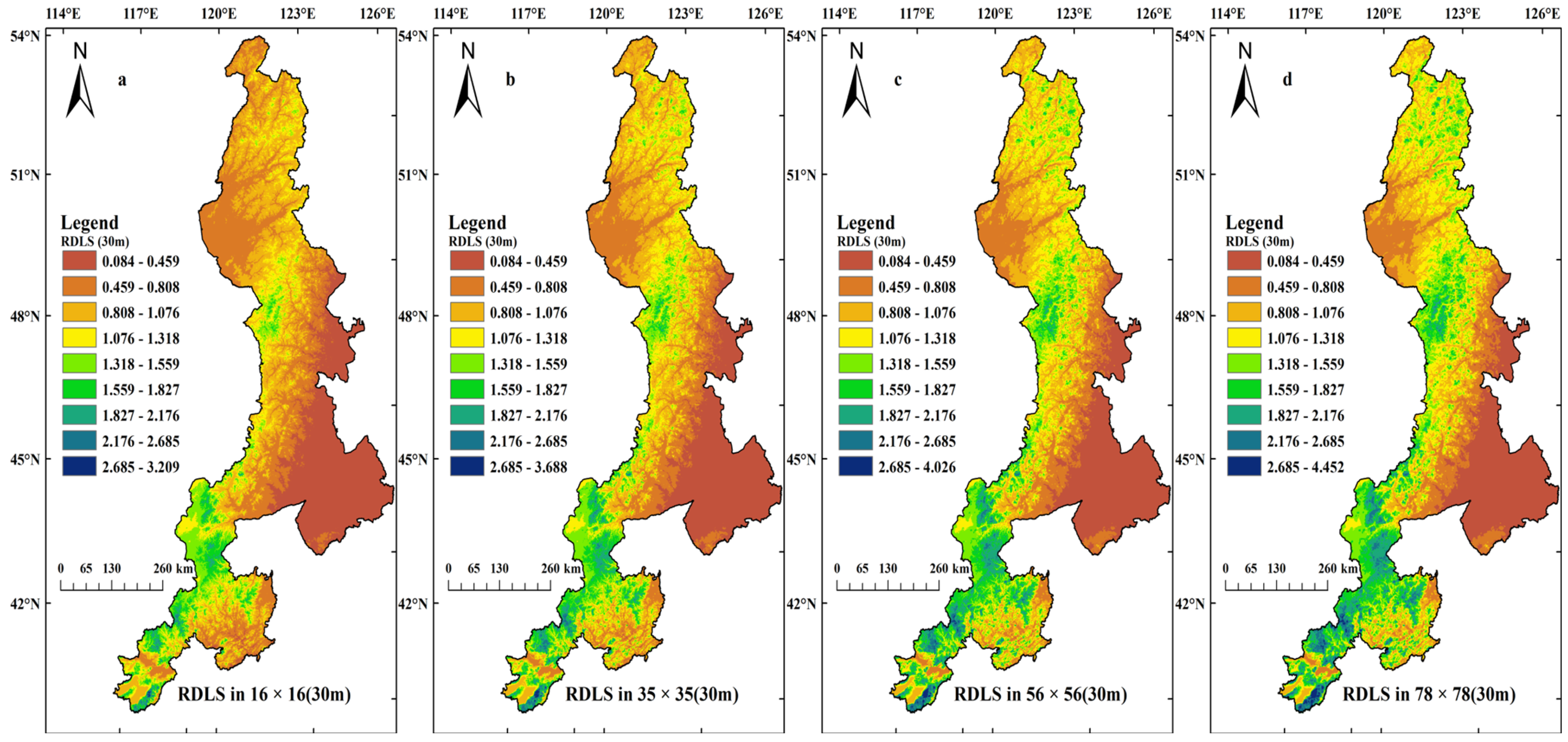
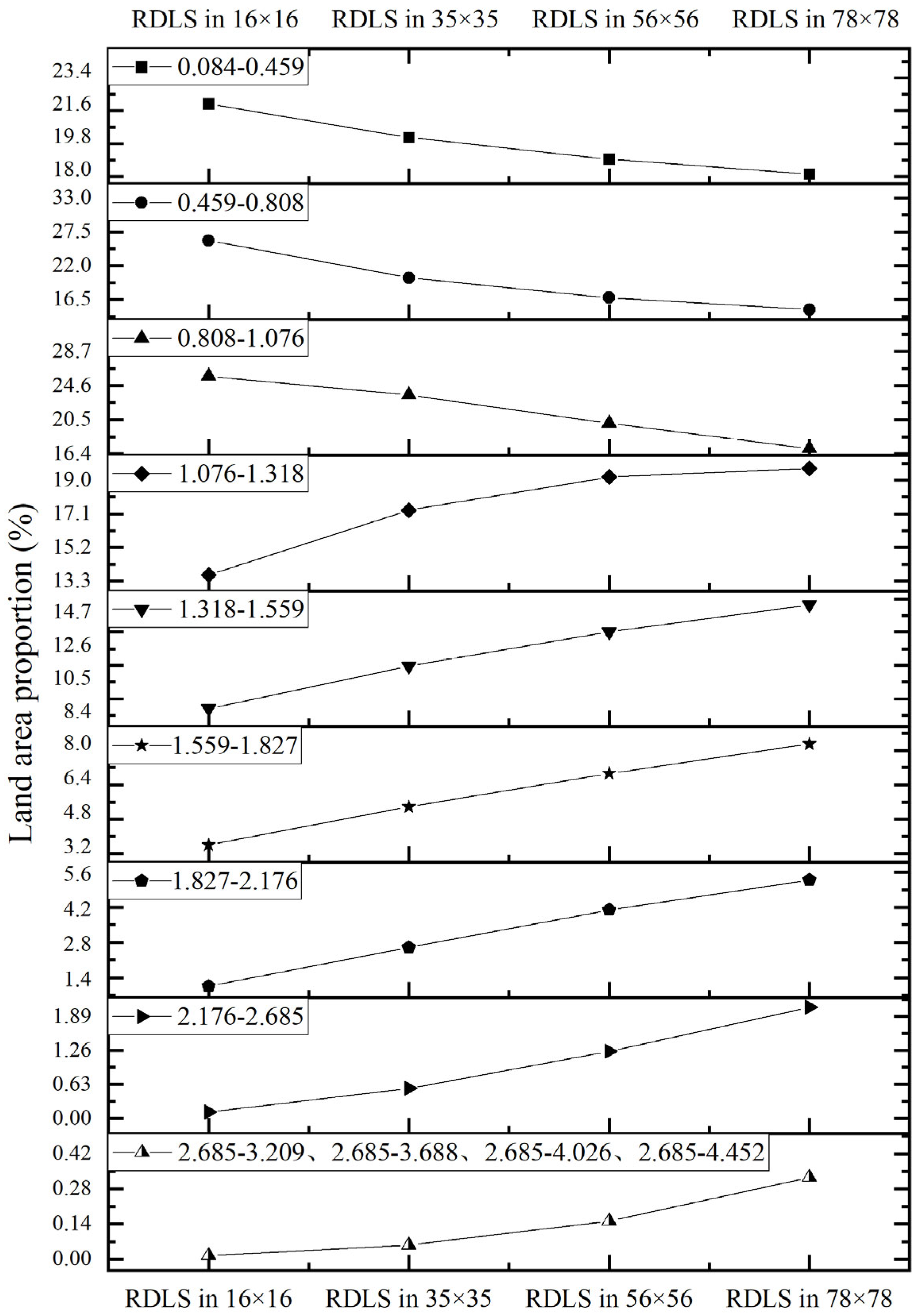
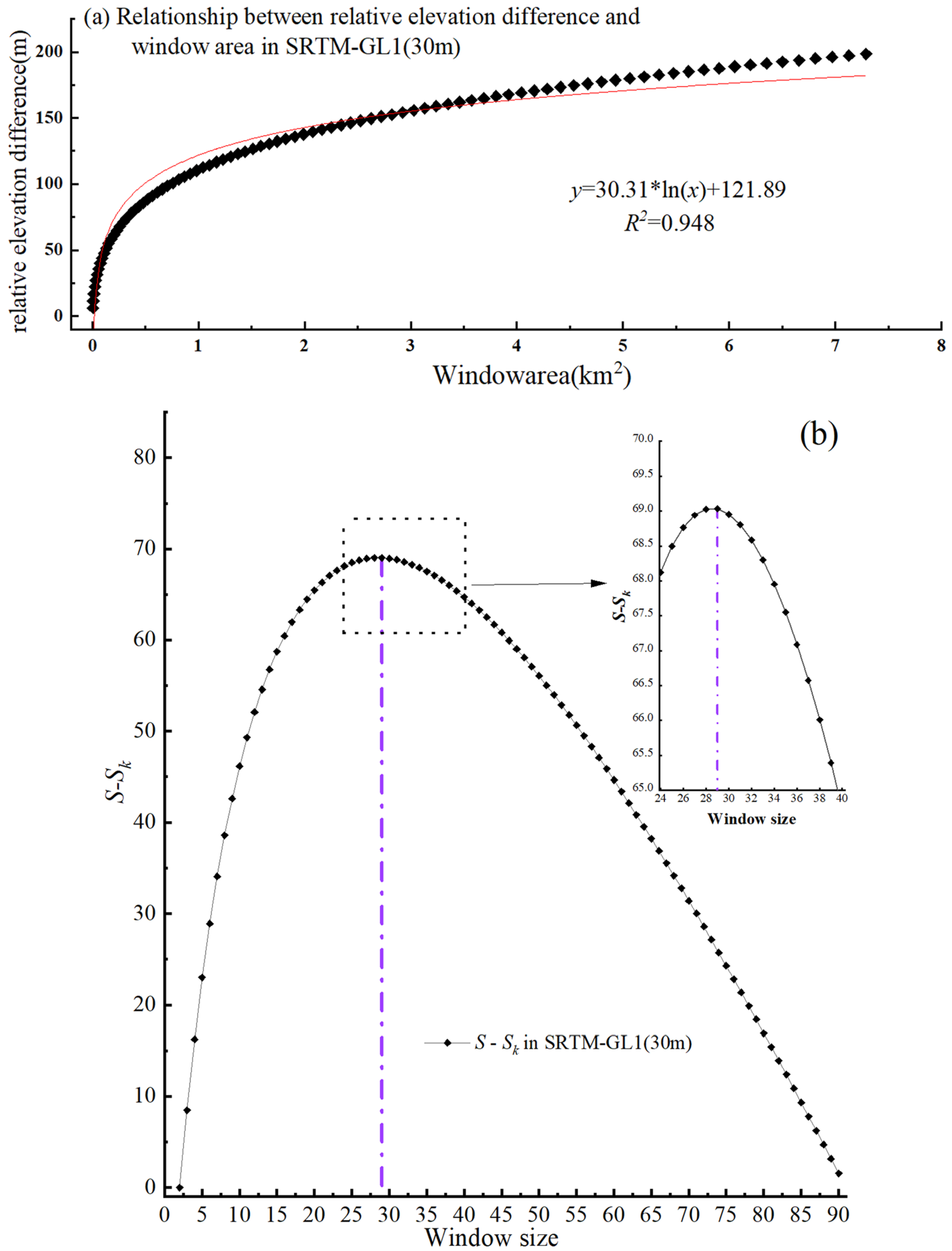
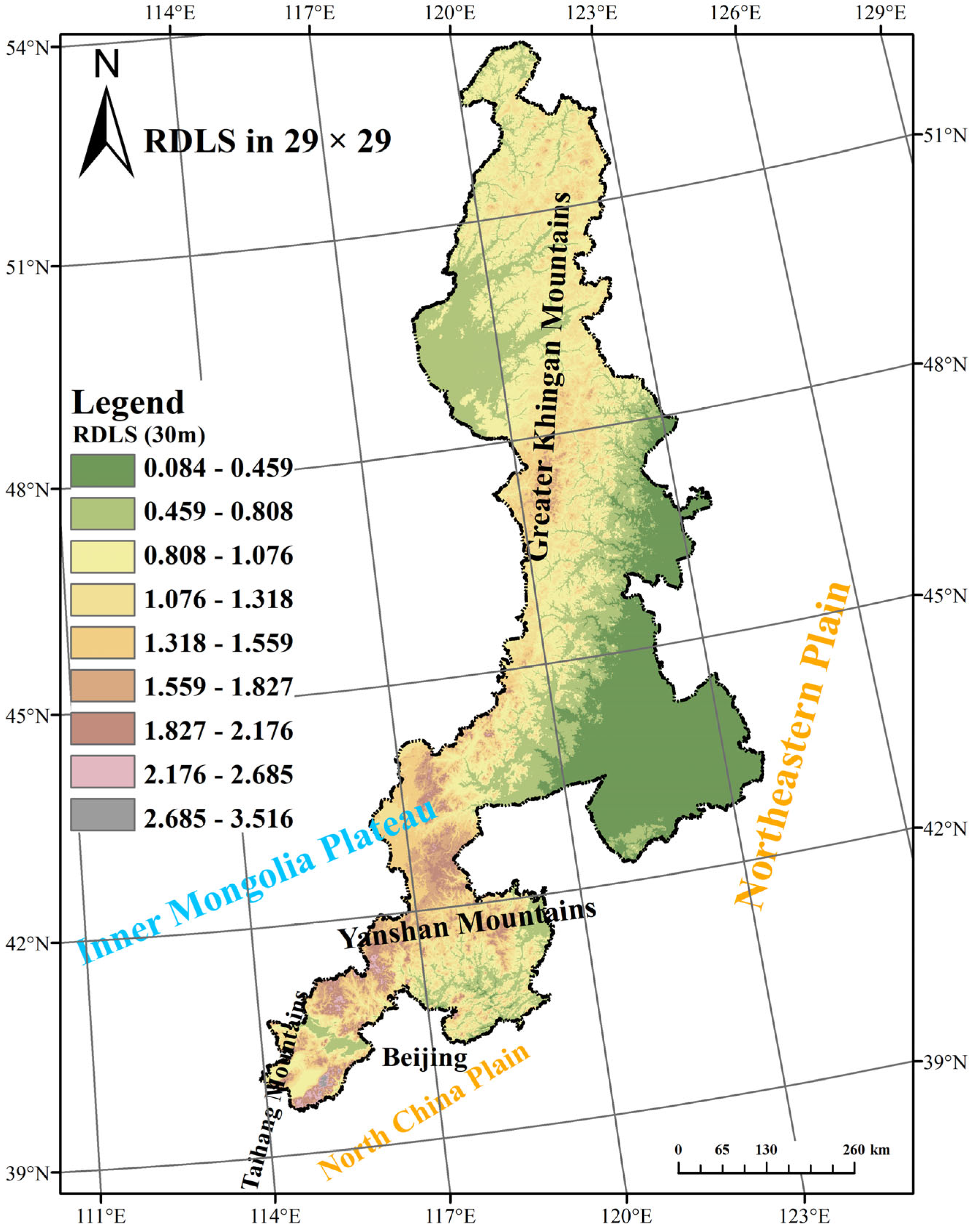
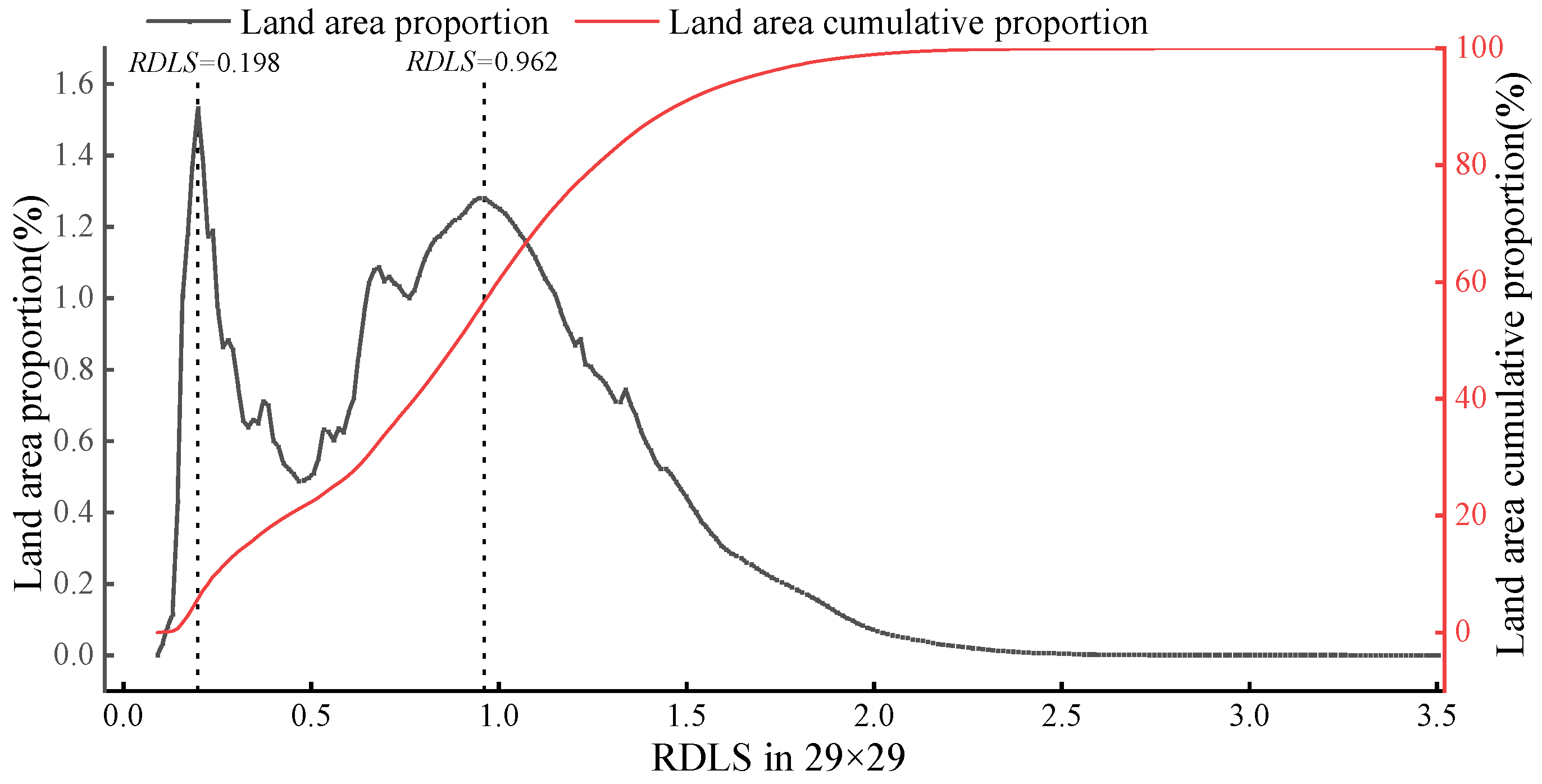
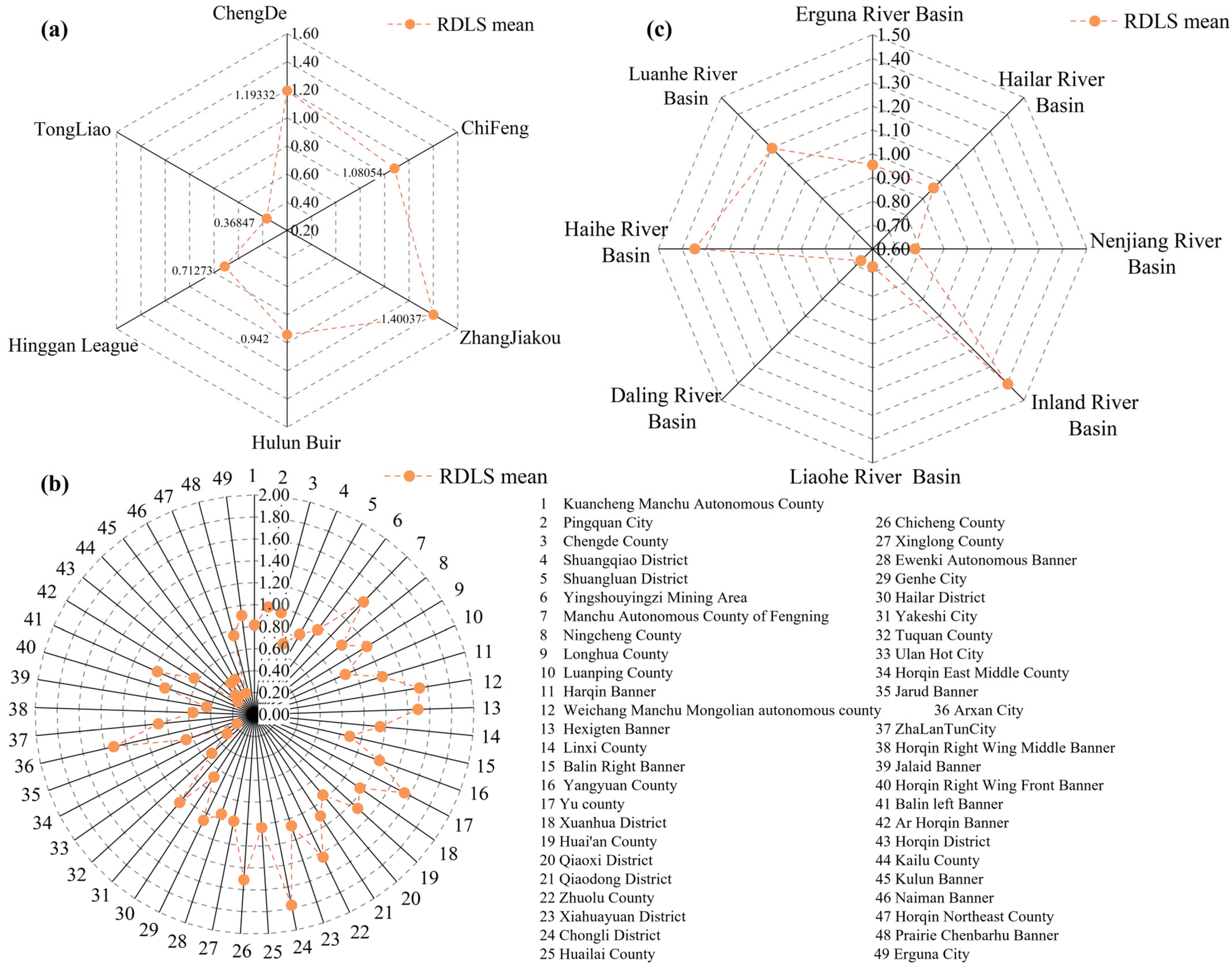
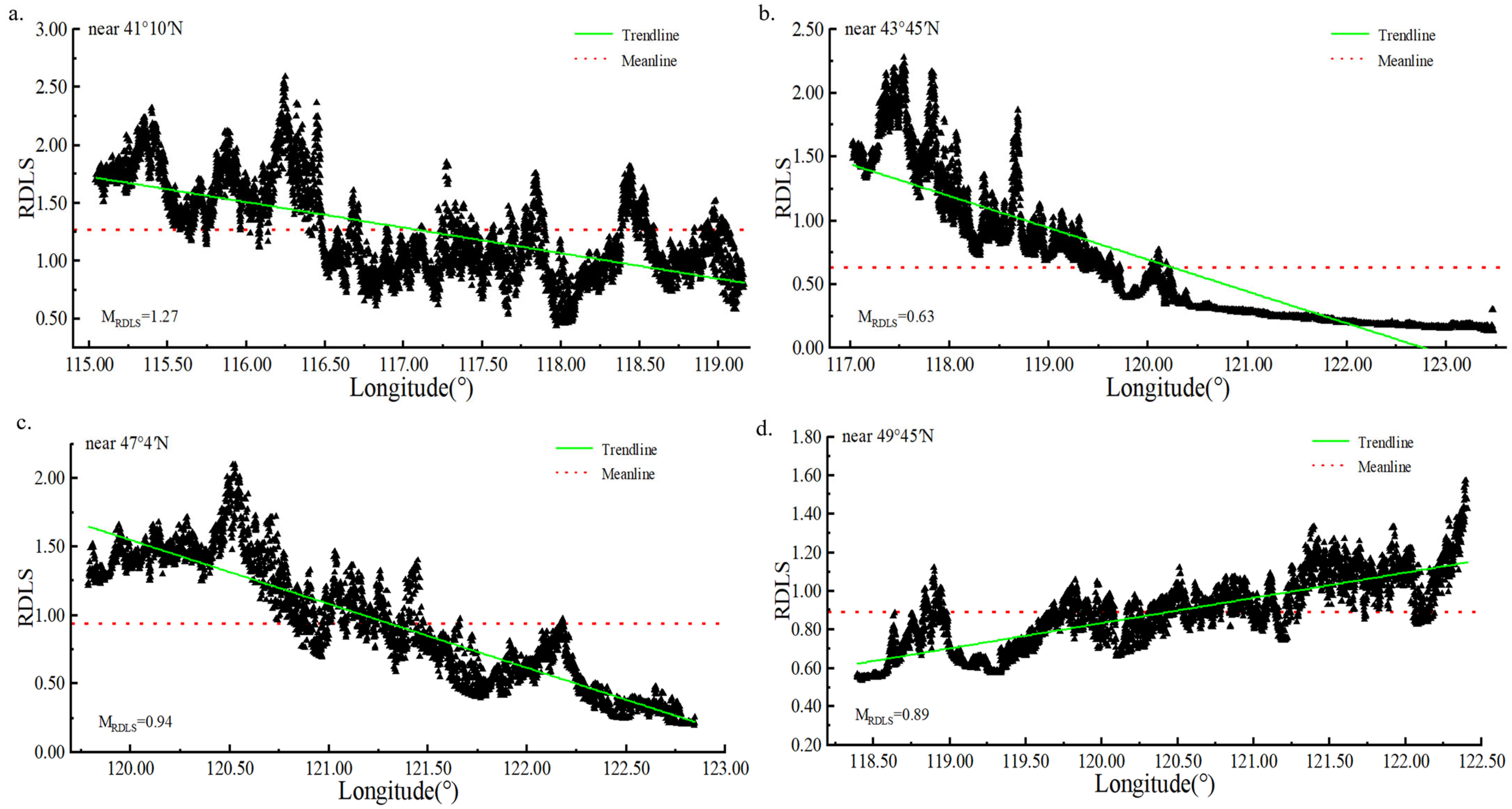
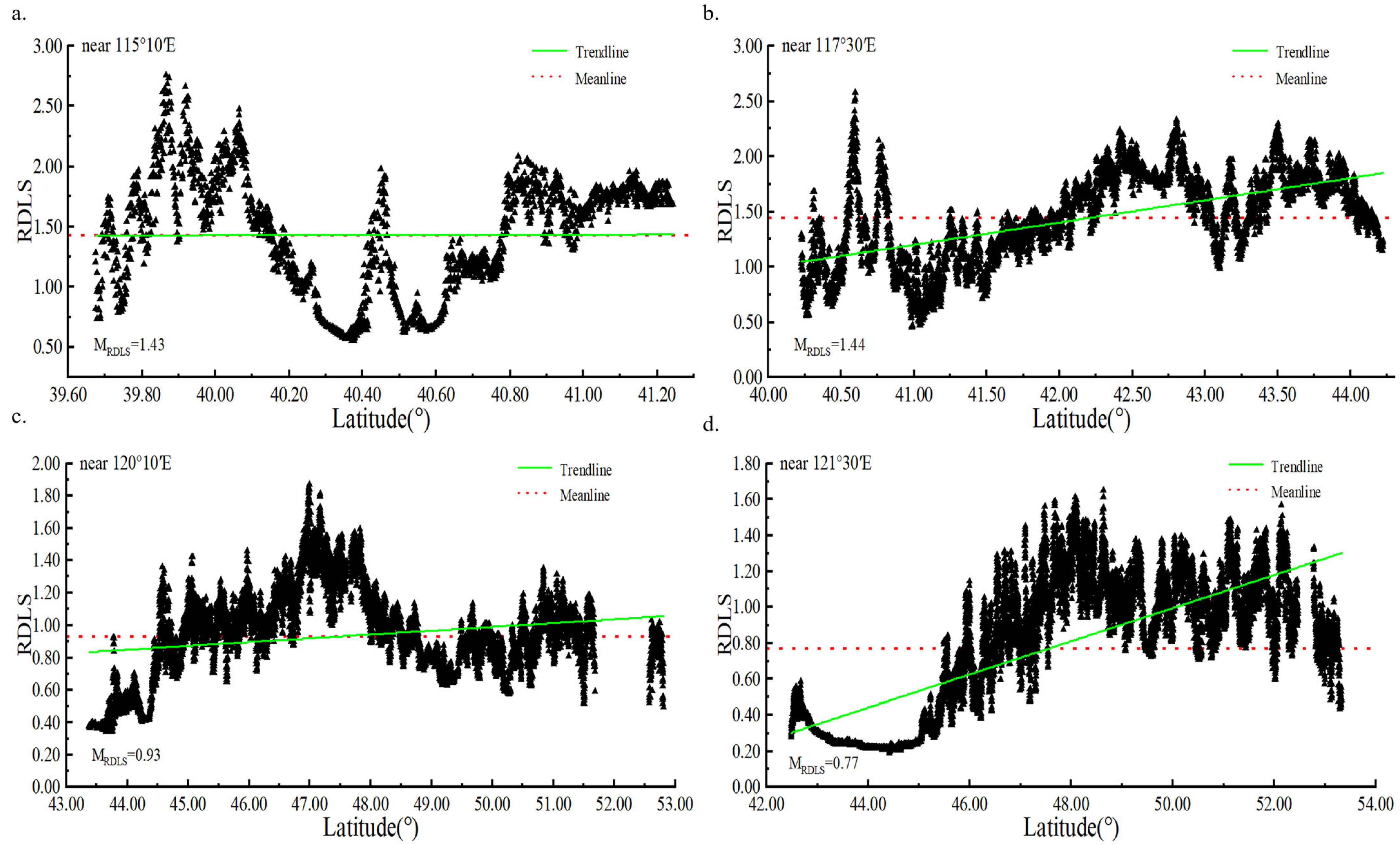
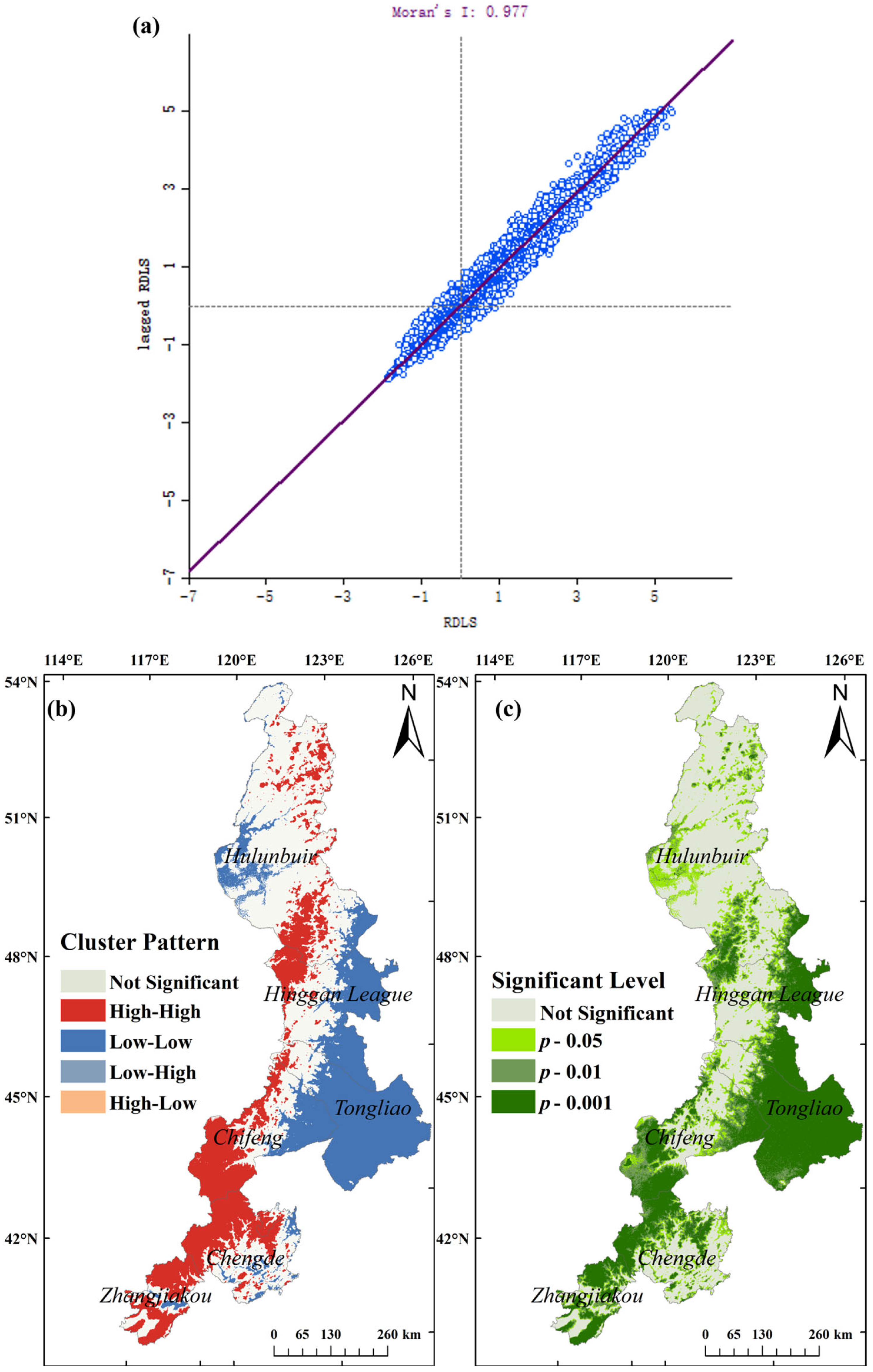

Disclaimer/Publisher’s Note: The statements, opinions and data contained in all publications are solely those of the individual author(s) and contributor(s) and not of MDPI and/or the editor(s). MDPI and/or the editor(s) disclaim responsibility for any injury to people or property resulting from any ideas, methods, instructions or products referred to in the content. |
© 2024 by the authors. Licensee MDPI, Basel, Switzerland. This article is an open access article distributed under the terms and conditions of the Creative Commons Attribution (CC BY) license (https://creativecommons.org/licenses/by/4.0/).
Share and Cite
Hu, L.; Feng, Z.; Shen, C.; Hai, Y.; Li, Y.; Chen, Y.; Chen, P.; Zhang, H.; Wang, S.; Wang, Z. Geospatial Analysis of Relief Degree of Land Surface in the Forest-Steppe Ecotone in Northern China. Forests 2024, 15, 1122. https://doi.org/10.3390/f15071122
Hu L, Feng Z, Shen C, Hai Y, Li Y, Chen Y, Chen P, Zhang H, Wang S, Wang Z. Geospatial Analysis of Relief Degree of Land Surface in the Forest-Steppe Ecotone in Northern China. Forests. 2024; 15(7):1122. https://doi.org/10.3390/f15071122
Chicago/Turabian StyleHu, Lili, Zhongke Feng, Chaoyong Shen, Yue Hai, Yiqiu Li, Yuan Chen, Panpan Chen, Hanyue Zhang, Shan Wang, and Zhichao Wang. 2024. "Geospatial Analysis of Relief Degree of Land Surface in the Forest-Steppe Ecotone in Northern China" Forests 15, no. 7: 1122. https://doi.org/10.3390/f15071122
APA StyleHu, L., Feng, Z., Shen, C., Hai, Y., Li, Y., Chen, Y., Chen, P., Zhang, H., Wang, S., & Wang, Z. (2024). Geospatial Analysis of Relief Degree of Land Surface in the Forest-Steppe Ecotone in Northern China. Forests, 15(7), 1122. https://doi.org/10.3390/f15071122





